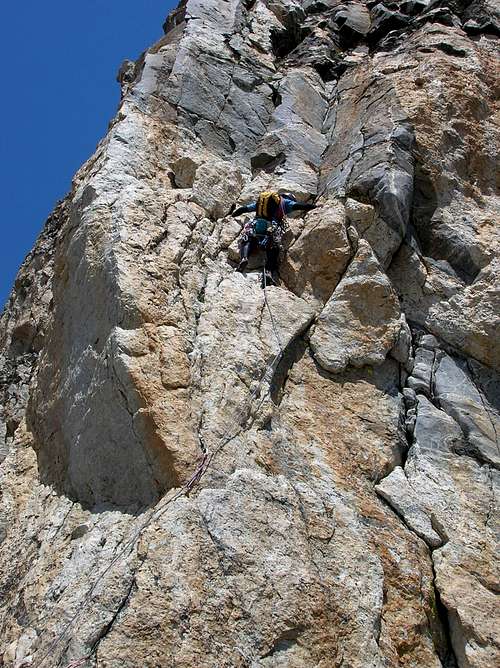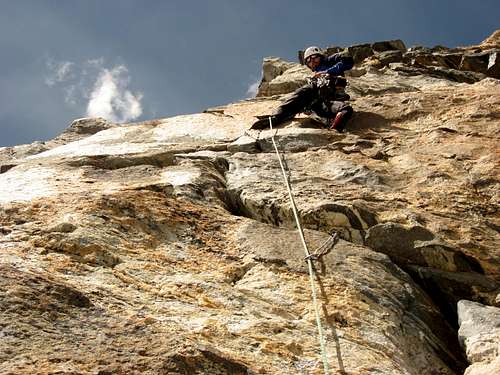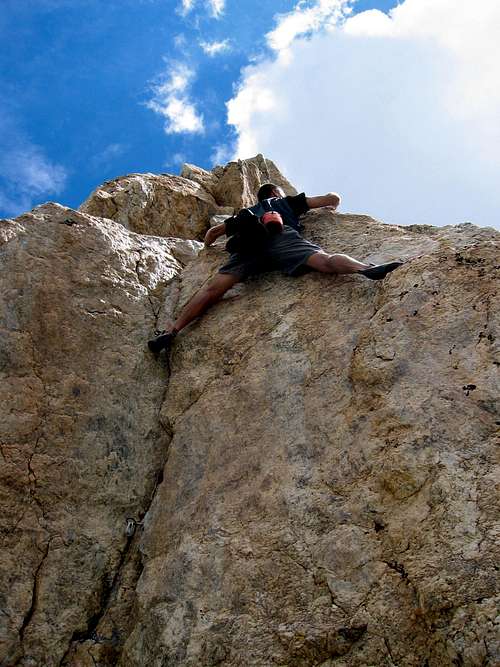-
 21241 Hits
21241 Hits
-
 73.06% Score
73.06% Score
-
 3 Votes
3 Votes
|
|
Route |
|---|---|
|
|
43.72889°N / 110.78777°W |
|
|
Trad Climbing |
|
|
Spring, Summer, Fall, Winter |
|
|
Most of a day |
|
|
5.8 (YDS) |
|
|
6 |
|
|
II |
|
|
Irene's Arete
First climbed way back in 1957 by John Dietschy and Irene Ortenburger, Irene's Arete climbs a very impressive, prominent prow along the Southwest side of Disappointment Peak, above Garnet Canyon. The route ascends for roughly 6 pitches along great hand cracks and dihedral systems. The route does not top out on the actual summit of Disappointment Peak, rather several hundred feet down a talus field, yet bagging the summit after an ascent of Irene's would be very resonable if one wished to do so. The route can be done car-to-car by fit climbers in as little as half a day, assuming the approach goes smoothly. Descent is made either by scrambling down a gully to the left of the route, or better yet, walking off the east side of Disappointment Peak to Amphitheater Lake, and returning to Lupine Meadows via the trail. This is a very good introduction to longer Teton climbs, without the monster approach or relative loose rock.
Approach
From the Lupine Meadows Trailhead, take the trail towards Garnet Canyon, passing two junctions and ascending about 3000 feet. Every junction is very well signed. After entering Garnet Canyon, continue though a boulder field and some meadows. At this point, Irene's Arete will be visible as the obvious sharp arete to the north. Follow the trail up some steep switchbacks to the junction for the Petzolt Caves. Leave the main trail here and pick up a faint climbers trail that breaks off the right (east). Follow broken, tree covered ledges and steps along to the base of the massive prow that Irene's is located on. Some sections of this part of the approach can become a little exposed if you get off-route. Follow the rubble covered ledge system (the highest of the tree covered ledges) to where the ledge ends at the point of the arete. The route starts here.
Route Description
This phenomenal route mostly climbs the right side of the arete, with a few short exceptions. Many variations exist on every pitch, some with difficulties up to 5.10a.
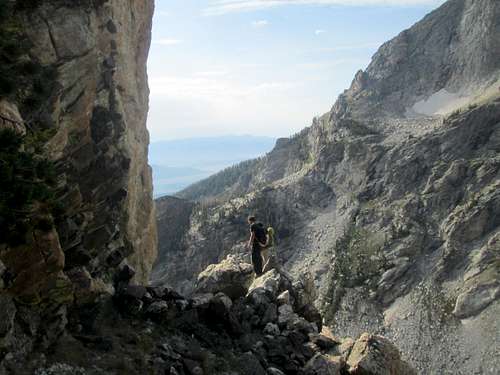
The pedestal at the start of the route. From this ledge, step around the corner to the beginning moves of the first pitch.
Pitch 1: From the pedestal at the end of the ledge, step around to the right side of the arete and climb shallow 5.7 cracks up lower angle terrain, trending right. Pass some easier ground and an optional belay, and ascend up a steeper, black featured wall. Continue up straight cracks at 5.8+ or make a delicate 5.7+ slab move to the right and gain a large ledge. Either way, move the next belay up and left to the highpoint of the ledge at the arete proper. This pitch is actually 2 pitches technically, but I will describe it as one, as it is very easy to combine both pitches. (5.7 150 ft.)
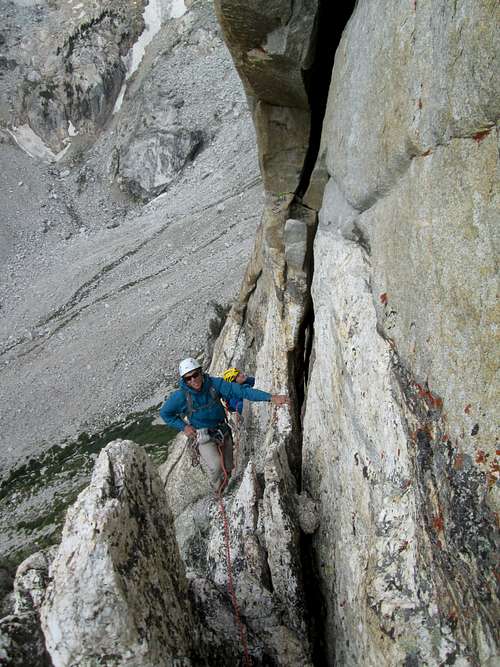
The end of the first pitch, taken from the ledge. One could alternatively climb crack straight up from where the lower climber is, which would deposit you further up the ledge.
Pitch 2: Climb up just to the left of the ridge line and step back right to a fixed pin (5.7 R), or climb straight up from the ledge at 5.10. Continue up through black, featured rock and head over to the left side of the arete, and up a 5.8 dihedral. Traverse more to the left, and then continue straight up a hand/finger crack to the next large ledge. (5.8 140ft.)
Pitch 3: From the comfy belay ledge, many options exist. The left line is the original line, which follows awesome 5.8 cracks along the arete. Straight up from the belay offers more awesome 5.8 hands through featured rock, and the right cracks offer slightly harder climbing. Pick your line and climb up to the next large ledge, below a short dihedral with a finger crack in the back of it. (5.8 120 feet.)
Pitch 4: Either climb straight up the 20 foot dihedral (5.9, recommended), or traverse to the right and then back left (5.7). Pull over a small bulge and follow the now much easier ridge to a large block, sling it, and belay. (5.9, 120 feet).
Scramble along the 4th class ridge for several hundred feet to a notch and a headwall. Stronger climbers may want to simul or solo this section, but those less experienced or fear exposure may want to rope up.
Pitch 5: From the notch, downclimb slightly to a left angling crack. Climb the crack for about 10 feet, place a piece, and make a delicate step across move onto the smooth slab to the right (5.8). Climb up and through a small weakness in the roof (5.7 awkward). Belay just above the roof. (5.8 50 feet.)
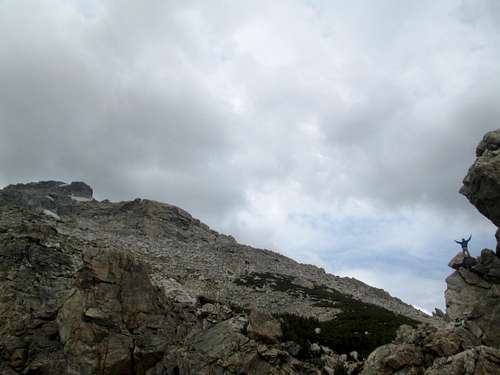
Kiff triumphant at the end of the technical climbing of Irene's Arete. The summit of Disappointment Peak and the Grand are visible up to the left.
Scramble further along the ridge, aiming for the left side of a large gendarme at the top of the arete. Skirt the gendarme on its left side and that will deposit you on the plateau of Disappointment Peak's east side. Again, less experienced climbers may want to rope up for this section.
Descent: From the end of the ridge, pick up a faint climber's trail that heads east down the hill and onto the plateau, though a stunted forest. This trail will lead down to Amphitheater Lake, but first descends some exposed 4 class slabs. Those less experienced may want to rope up for this section.
Alternatively, one may also descend to the base of the route by heading to the second gully to the left (west) and downclimbing or rapping down to the tree covered ledge system at the base of the rote.
Essential Gear
Standard rack of nuts and cams from small to 3". Doubles in mid to hand size cams helpful, though not necessary. A dozen slings/runners is sufficient and one 60 meter rope.
Links
Mountain Project page.
Teton Rock Climbs by Aaron Gams details many classic and not-so-classic routes in the Tetons.




